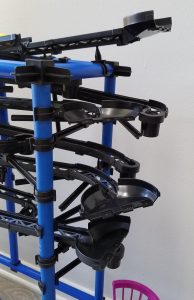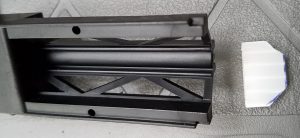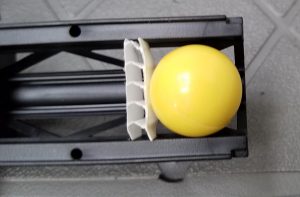Math Monday: Access to Addition
[sharethis]
Let’s face it. There are easier ways to count a pile of marbles than to deposit them one by one into either of the machines we’ve built over the last couple of weeks. Can’t we build a machine that would do something at least slightly more useful? Like at least add two numbers?
The pleasant surprise is that every counting machine is already an adding machine, or very nearly so. All we need to do is append multiple insertion points for marbles. The entry chute we’ve been using drops into the ones place, and a single marble entered there represents adding one. But if we add a chute that drops into the same location as a carry from the the first trap — i.e., goes into the second trap directly — then depositing a marble there represents adding the value of the second place, which for last week’s machine is three. If we introduce an input chute for every one of the traps, then we will get something that looks like this:

Now, starting with all of the places empty, we can quickly set the machine to represent any number we like by putting into each chute the number of marbles equal to the corresponding digit of the ternary numeral (with the leftmost, or most significant, digit going in toward the bottom and the rightmost, or least significant, digit at the top). We no longer have to insert the marbles one by one to count up to that number. More importantly, the accumulation-and-carry mechanism of the machine works with marbles inserted in any of the chutes, so we can add any other number to the current state of the machine by simply depositing the corresponding number of marbles from its ternary representation into each of the chutes. Here’s an example of entering 14 (in ternary, 112) and adding 17 (ternary 122) to it.
As you can see, the machine ends showing 1011 in the traps. That’s ternary for 31 — which is indeed the sum of 14 and 17. Eureka! Marble addition base three works.
For fun, here’s a video of 80+1, (or 2222+1 in ternary) so that you can see all of the possible carries (and see the machine finally overflow).
We’ll make one more unusual modification to our ever-more-complex marble machine next time, but for now, here are the details I promised last week for constructing an escapement. You start with a Chaos Toy bell component, which easily comes apart into the framework and the clapper arm as shown below (with the clapper arm upside-down).

You can see in the picture that there is a rib of plastic right down the center line of the bottom of the clapper arm. That’s unfortunate, because that blocks the channel that on most Chaos Toy pieces provides a place to connect the ball joints provided to support pieces and hold them in position. I imagine that the designers put that rib there because generally speaking, it’s not a good idea to connect to the clapper arm of a bell component — after all, if the arm is immobilized, the bell won’t work. But in our case, we are going to want to link the clapper arm to the similar arm of the associated trap component, and the easiest way to do that is to snap a ball joint into each of the arms and connect them with a cross beam (more on that later). The upshot is, we need to remove enough of that central rib, with a utility knife or small handheld grinding tool, to make enough room to connect a ball joint, as shown in the picture on the left below.
There’s also a thin lip proud of the edge of the channel on its top side, which you can see on the far edge of the component in the picture on the right above, that also needs to come off. (We will later be gluing another piece of track onto the top of the channel, so the top surface of the channel needs to be flat.) This slices off easily with a utility knife.
The next step is to cut out an insert, as shown in the picture on the left below, that matches the cross section of the marble channel. You can use any lightweight, stiff material with enough thickness so that you’ll be able to fasten it into the track with glue or double-sided tape. Corrugated plastic as shown works admirably. The right-hand picture below shows how to position the insert, which will act as a stop to ensure that exactly one marble enters the escapement at a time. You want there to be just barely enough room for that marble.
Once you have it positioned correctly, secure the stop in place.
Now we are in the home stretch of creating the escapement. Cut a section of track from another Chaos Toy piece, slightly shorter than the track on the clapper arm. (Save for this purpose any pieces that break while you are making marble machines.) Remove the same lip along the top of that track section that you removed from the clapper arm, and glue it upside-down onto the clapper arm to create a tunnel. Then cut a tab from cardstock and tape it at the top of the opening of the tunnel, producing something that looks basically like this.

A bit more on the tab: it should be slightly narrower than the width of the channel, and about twice as tall as the “tunnel” you’ve created. You may also need to snip a bit out of the center of the bottom of the tab to make sure a marble just fits through the opening when the arm is in its up position. You can see all of these details more clearly in the following photo looking straight on to the escapement.

Finally, it’s time to link the escapement to one of the traps. First, you have to remove the same section of the center rib underneath the trap as you initially did with the bell component. Then, as shown below, flip the two components over, align them in parallel and tape them together at their far ends to hold their relative positions, and then click in two ball joints linked by a connector arm so that the arms of the trap and the escapement will rise and fall in unison.

And that’s it — here’s the finished escapement-trap assembly, ready to install into your counting machine.

A final word on weighting the assembly: the picture above shows extra weight on the trap, to balance the leverage of the single ball that sits in the escapement. Ultimately, I found that the assembly worked more reliably if the escapement was itself counterweighted so that it was essentially in balance without the trap when its ball was in place, and the trap was properly weighted for the number of balls it was intended to hold, and then the two were linked. In the next post, you’ll be able to notice that sort of weighting scheme on most of the escapement-trap assemblies.
















